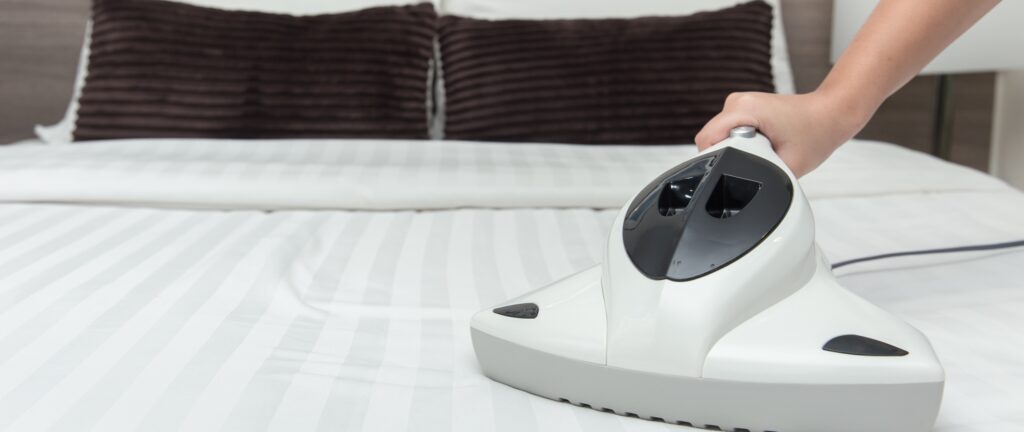How Wool Creates a Healthier Sleeping Space
We heard it all the time growing up—make your bed! Our mothers might not like it, but in recent years, experts have begun to challenge this conventional wisdom, suggesting that leaving your bed unmade might actually be better for your health.
We find this intriguing, because for years, we’ve been encouraging folks to wait an hour or so before making their beds when they sleep with wool. So we thought we’d look into the recent trend and see what it’s all about.
Let’s explore why allowing your bed to “breathe” contributes to a cleaner, healthier sleep environment.

Word on the Streets
When you sleep, your body naturally releases heat and sweat, creating warm, damp conditions—ideal for dust mites to thrive. Dust mites are microscopic organisms that feed on dead skin cells, and they love humid, enclosed spaces like a neatly tucked-in bed.
All sorts of practitioners, including allergists and environmental health specialists, are recommending leaving your bed unmade for several hours after you wake up to allow your bedding to breathe. Apparently, social media channels like TikTok are full of the advice as well. By simply pulling back your sheets and exposing your mattress and bedding to fresh air, you allow for light and better ventilation, which keeps the bed drier and less inviting for mites.
Why Dust Mites Are a Problem in the Sheets
Dust mites may be tiny, but their impact on health can be substantial. These microscopic creatures don’t bite, but their feces and body fragments can become airborne and trigger a range of allergic reactions. Dust mite allergies are common and can lead to symptoms such as sneezing, itchy eyes, coughing, and even asthma attacks. Over time, exposure to dust mites can exacerbate respiratory issues, making it harder to breathe easily in your own bed.
For people with existing allergies, asthma, or other respiratory issues, reducing dust mites is particularly important. Since these allergens often accumulate in bedding, pillows, and mattresses, airing out your bed can significantly reduce your exposure to dust mites, helping to create a healthier sleeping environment.

Wool: The Natural Solution for Dust Mite Prevention
When it comes to dust mites, wool is pretty cool! Unlike synthetic materials, which can trap moisture and create a damp environment, wool bedding offers a natural, effective solution to the dust mite problem. There’s a reason that those with allergies and sensitivities—not to mention the generally health conscious—choose wool bedding and mattresses.
Moisture Management
Wool is highly breathable and moisture-wicking, meaning it pulls moisture away from your body and disperses it throughout the fiber. This wicking action prevents moisture from accumulating on the surface of your bed or next to your skin. Wool can absorb up to 30% of its own weight in moisture without feeling wet, allowing it to maintain a comfortable sleeping temperature while staying dry.
By managing moisture levels in your bedding, wool discourages dust mites from thriving. This makes wool bedding an ideal choice for anyone seeking a cleaner, healthier sleep setup.
Hypoallergenic
Despite rumors of wool allergies, wool is naturally hypoallergenic. Wool fibers are covered in a waxy substance called lanolin, which repels dust mites and reduces the chances of allergen buildup. In addition, the little buggers don’t like the feel of the rough fibers, so wool actively creates a barrier of protection for you from dust mites.

Practical Tips for a Healthier Bed Environment
If you’re ready to make the transition to a more breathable, dust-mite-resistant life, here’s how to get started:
- Leave Your Bed Unmade. Try to leave your bed unmade for at least 30 minutes after you wake up to allow moisture to evaporate and fresh air to circulate.
- Invest in Wool Bedding. Swap out synthetic or feather bedding for wool options. Hey! We know where you can find that.
- Wash Bedding Regularly. Washing your sheets and pillowcases at least once a week can help reduce dust mites and allergens.
- Let There Be Light. Wool bedding benefits from periodic exposure to sunshine. Dust mites do not.
- Switch Out Your Pillow Periodically. It’s said that after two years of use, 10% of a pillow’s weight is…forgive us…dust mite bodies and feces. For real. Wool pillows will keep this down to a minimum.
- Ventilate Your Room. Good air circulation can help keep your bed and bedroom environment fresher and drier, especially if you have wool bedding that benefits from airflow.
- Clean It Up. If you have a known dust mite allergy, steam cleaning surfaces and vacuuming regularly can help.
- Consider a Wool Mattress Topper. Wool mattress toppers add a layer of protection and moisture management without trapping heat, making your bed even more inhospitable to dust mites. Check out our Travel Mate, Snuggle Mate, or Ashland Organic toppers!
Your Best Night’s Sleep
Leaving your bed unmade might feel counterintuitive, but it’s a simple habit that can promote a healthier sleeping environment. And with the addition of wool bedding, you can enhance your bed’s natural ability to manage moisture and discourage dust mites. By letting your bed breathe, you’re reducing the likelihood of dust mite buildup and ensuring a fresher, more hygienic sleep atmosphere.
So, the next time you consider tucking in those sheets and smoothing down the covers, remember that a little bit of “mess” can actually be a good thing. Just maybe don’t tell your mother…
Thanks for joining us! We’re glad you stopped by. There’s more on Instagram, and if you haven’t already, be sure to sign up for our Ewe’s Letter, chock full of good news, tips, and special offers for our loyal Dreamers. Until we meet again—sweet dreams!

